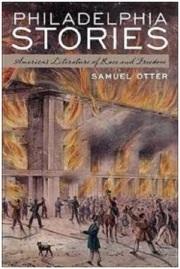Berkeley Books: "Philadelphia Stories: America's Literature of Race and Freedom" by Samuel Otter

This month in Berkeley Books we are delighted to feature Philadelphia Stories: America’s Literature of Race and Freedom (Oxford University Press, 2010) by Samuel Otter, Professor of English.
A historic city at the border between North and South, antebellum Philadelphia was home to one of the largest and most influential ‘free’ African American communities in the United States, and was seen by residents and observers as an experiment in freedom, a laboratory in which the possibilities of a future without slavery could be tested. Philadelphia Stories studies the literary tradition that emerged between 1790 and 1860, as the city became a stage on which issues of race, character, violence, and liberty were acted out before the nation. With an interdisciplinary approach that brings together “historical work on race, character, and politics in Philadelphia, the emphasis on the local in American Studies, a cultural geographers’ insistence on circulation and implication, and a respect for aesthetic complexity and surprise” (13), Otter argues for “a Philadelphia that revises our sense of literary place” (13), and proposes that “the city is as crucial to understanding United States literary history as Boston, Concord, or New York” (3).
Otter’s account of the literary culture that develops out of this unique location situated at the intersection of slavery and freedom moves from the yellow fever epidemic that devastated the city in 1793, to disfranchisement in 1838, to the riots of the 1830s and 1840s that targeted African American residents, to writing about freedom in letters, novels, and treatises of the 1850s. The four chapters, “Fever,” “Manners,” “Riots” and “Freedom” analyze texts by canonical authors like Charles Brockden Brown, Edgar Allan Poe, and John Edgar Wideman, lesser-known writers like Hugh Henry Brackenridge, George Lippard, and Frank J. Webb, and obscure figures like Mathew Carey, Robert Montgomery Bird, William Whipper, and Joseph Willson. Otter studies diverse textual forms: correspondence, fever accounts, records of black national conventions, riot novels, and recipes, as well as visual artifacts such as maps, caricatures, book covers, physiognomic portraits, and hollow-cut silhouettes.
Proposing that “In the middle of the nineteenth century, Philadelphia came into fiction, and fiction became Philadelphian” (8), Otter finds the specificity of the city’s literary tradition in part in the ways in which the rigid regularity of the urban grid becomes a critical figure for writing about the experiment of freedom. He writes: “Hypotheses about freedom are lived by those who move through its spaces and encounter networks of imperatives, enticements, and prohibitions” and ultimately “redraw boundaries and establish alternative maps of the city” (9). A second topos Otter isolates in Philadelphia’s literary tradition is a thematic interest in surfaces: skin, manners, maps, streets, parlor floors, and tabletops. Otter's close readings of these topoi, and his incisive analysis of their political and historical stakes, lead John Stauffer, Professor of English, American Literature, and African American Studies at Harvard to write of Philadelphia Stories: “Otter's close readings are simply brilliant, and the way he connects literature to history, text to life, is a model of interdisciplinary scholarship.”
Contesting a tradition in writing about Philadelphia that dismisses the city’s literary production, Otter establishes Philadelphia as fundamental to understandings of the imaginative, as well as political life of nineteenth century America. By challenging the narrative about a city, Otter's remarkable work forges a powerful synecdoche in which, “the part skews the whole” (280), while developing a poignant reflection on what place means for literature itself. Wai Chee Dimock, William Lampson Professor of English and American Studies at Yale calls Philadelphia Stories "A stunning local story that radiates outward to give us a transformed understanding of nineteenth-century America.”
In this week’s Biblio-File, Otter shares nine titles that shaped his thinking while working on Philadelphia Stories. His recommendations include the influential but much contested argument by F. O. Matthiessen in American Renaissance: Art and Expression in the Age of Emerson and Whitman about the aesthetic and political emergence of an American literary tradition in the debates among a crucial set of writers about symbolism and democracy, and Eric J. Sundquist’s expansion and revision Matthiessen’s work in To Wake the Nations: Race in the Making of American Literature. Selections like Russian Formalist Victor Shklovsky’s “Art and Technique,” which contends that artistic language impedes and alters perception, and Emma Jones Lapsansky’s Neighborhoods in Transition: William Penn’s Dream and Urban Reality, which analyzes the relationships between the city’s vaunted grid plan and its actual settlement and evolution, point to the interdisciplinary approach of Philadelphia Stories, and its attention to aesthetic objects and urban design as well as literary texts.